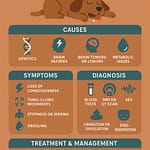No solid India-based studies exist yet, but here’s what’s speculated or observed globally in animals:
1. Heightened Anxiety or Restlessness
Some animal behaviorists suggest that EMF exposure may impact neurological functions in sensitive species. Dogs — especially strays already living in high-stress environments — may experience:
- Increased pacing or howling
- Unusual aggression or fear responses
- Disruption of sleep/rest cycles (yep, dogs have those too)
2. Auditory Irritation
Dogs hear in a frequency range of 40 Hz to 60 kHz — way beyond human ears. While 5G frequencies themselves are technically above that range, associated infrastructure (like smart poles, power supplies, and transformers) may emit subtle buzzing or high-pitched noise. Think of it like living next to a mosquito that never shuts up.
3. Disruption of Navigation or Homing Instincts
There’s ongoing global research into how electromagnetic fields affect animals’ natural navigation — particularly in birds and bees. Dogs, too, are thought to use Earth’s magnetic field subtly while navigating. Interference could mess with that spatial orientation, making it harder for strays to return to known shelters or food spots.
4. Increased Urban Chaos = More Stress
Let’s face it: 5G rollout = more digging, drilling, tower installation, noise, and lights. Stray dogs living near construction zones often suffer from:
- Loss of territory
- Loud noise phobias
- Higher chances of accidents and injury
If anything’s making Indian strays more jumpy, it’s probably a combo of this environmental disturbance and tech-fueled urban development.
🧪 But… Where’s the Proof?
There’s no peer-reviewed, India-specific study yet directly linking 5G exposure to negative health outcomes in stray dogs.
Most info we have comes from:
- Anecdotal field reports from rescuers/vets noticing more erratic behavior
- Research on lab animals under high EMF exposure (far more than what 5G towers emit)
- Hypotheses, not conclusions
So let’s not put the blame squarely on 5G. Yet.
🧭 Real-Life Impact Seen by Street Vets & Feeders
Some NGOs and street animal feeders have informally reported:
- Dogs abandoning familiar spots after towers are installed
- Skittish behavior near new infrastructure
- Barking frenzies at certain poles or transformers at odd hours
Coincidence? Could be. But it’s worth exploring further with field studies and behavioral observation.
🛠 What Can Be Done Right Now?
While the jury’s still out on 5G’s direct impact, here’s how we can reduce stray dog stress overall:
- Enforce noise limits during tower installation
- Avoid placing repeaters near known stray shelter zones
- Educate citizens to report displaced or panicked animals
- Support sterilization and feeding programs to stabilize the stray population
- Push for research funding to monitor wildlife and stray animal response to EMF-heavy zones
🐾 Bottom Line
5G is unlikely to be a laser gun aimed at our strays. But it might be a subtle environmental stressor — part of a bigger cocktail of urban problems: noise, heat, pollution, overpopulation, and habitat loss.
Until we have proof, let’s stay alert, observe more, and advocate for stray-friendly urban planning. Tech should uplift us — not leave our four-legged friends behind in the signal.

Dr. Suranjan Sarkar is a veterinarian and also a writer and editor for both print and digital with a love for travel, animal, and architecture. Much of his writing has focused on human and animal health and welfare. A life-long pet owner, His two favorite canine quotes are, “Be the kind of person your dog thinks you are,” and “Dogs communicate their feelings honestly and directly. There’s no hidden agenda or manipulation.”










